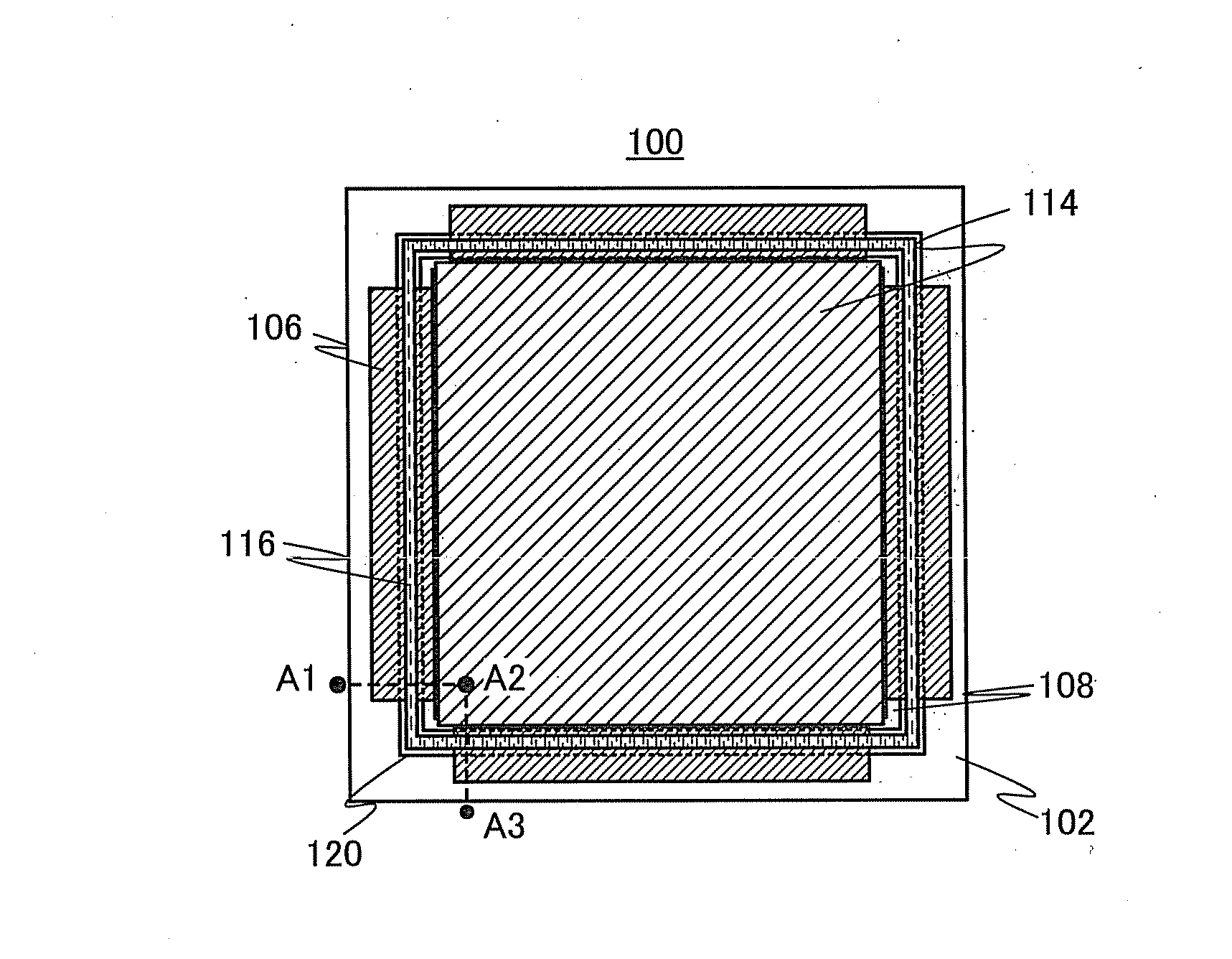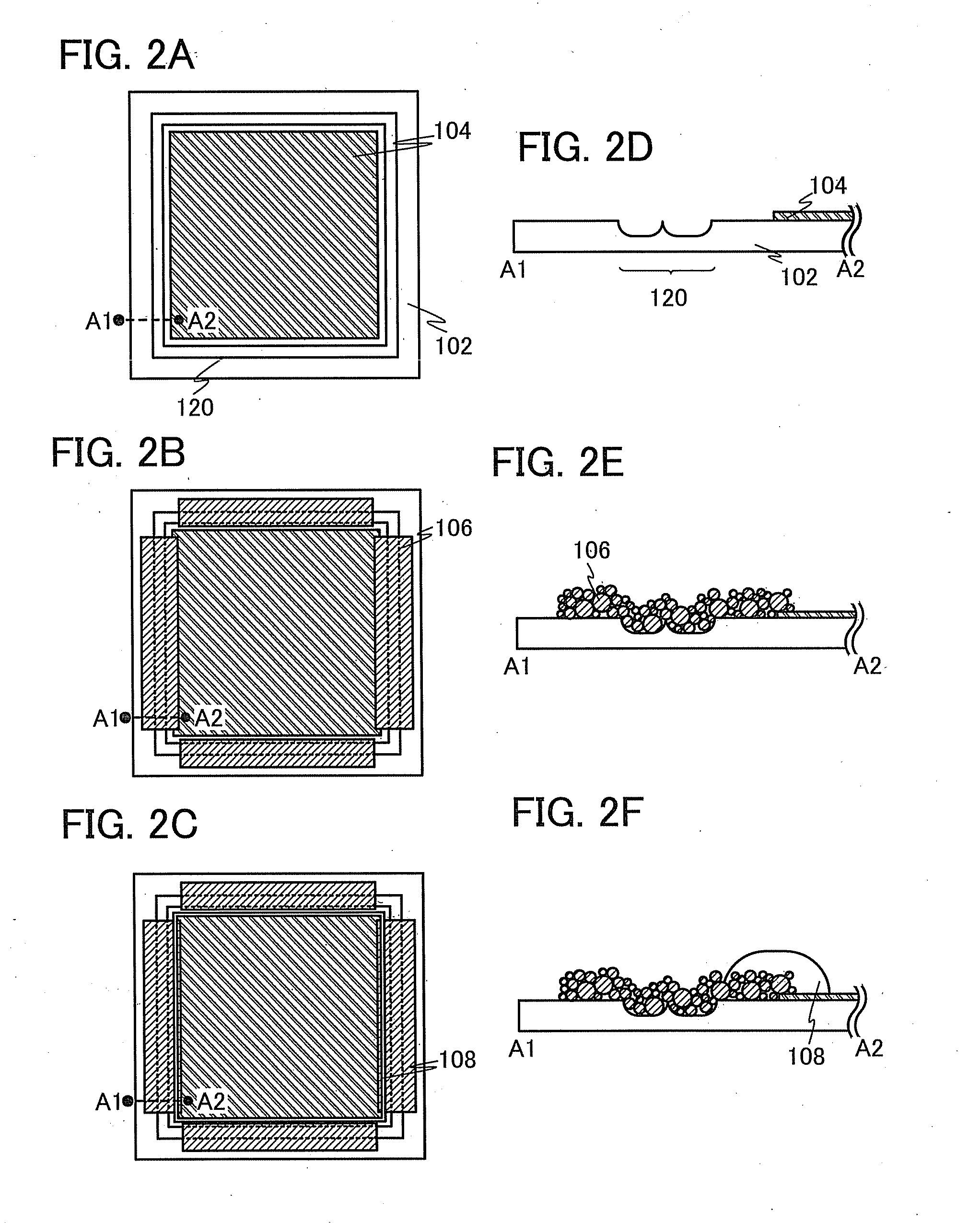Lighting Device and Method for Manufacturing the Same
- Summary
- Abstract
- Description
- Claims
- Application Information
AI Technical Summary
Benefits of technology
Problems solved by technology
Method used
Image
Examples
embodiment 1
[0035]One embodiment of the present invention will be described with reference to FIGS. 1 A to 1C. FIG. 1A shows a top view of a lighting device 100. FIG. 1B is a cross-sectional view along the dashed line A1-A2 in FIG. 1A. FIG. 1C is a cross-sectional view along the dashed line A2-A3 in FIG. 1A. Note that in FIG. 1A, some of components (e.g., a sealing substrate 118) are not shown to avoid complexity of the drawing.
[0036]The lighting device 100 shown in FIGS. 1A to 1C includes a substrate 102, an uneven region 120 formed in the substrate 102, a first electrode 104 formed over the substrate 102, a connection electrode 106 formed over the substrate 102, the uneven region 120, and the first electrode 104, a partition wall 108 covering the first electrode 104 and the connection electrode 106, a light-emitting layer 110 formed over the first electrode 104 and the partition wall 108, a second electrode 112 formed over the partition wall 108, the light-emitting layer 110, and a connection...
embodiment 2
[0075]In this embodiment, an embodiment different from the lighting device 100 described in Embodiment 1 will be described with reference to FIGS. 4A to 4C. Note that the same reference numerals are used for the same parts as those in FIGS. 1A to 1C, and description thereof will not be repeated.
[0076]FIG. 4A shows a top view of a lighting device 200. FIG. 4B is a cross-sectional view along the dashed line B1-B2 in FIG. 4A. FIG. 4C is a cross-sectional view along the dashed line B2-B3 in FIG. 4A. Note that in FIG. 4A, some of components (e.g., the sealing substrate 118) are not shown to avoid complexity of the drawing.
[0077]The lighting device 200 shown in FIGS. 4A to 4C includes the substrate 102, a microlens array substrate 124, an uneven region 120a formed in the substrate 102, a planarizing resin 122 formed over the substrate 102, the first electrode 104 formed over the planarizing resin 122, the connection electrode 106 formed over the substrate 102, the planarizing resin 122, a...
embodiment 3
[0096]In this embodiment, an example of an element structure of a light-emitting element exhibiting organic EL emission which is used in the lighting device of one embodiment of the present invention will be described. The light-emitting element exhibiting the organic EL emission generates a smaller amount of heat than an LED. Thus, an organic resin can be used for a housing, so that a reduction in weight of the lighting device is possible, which is preferable.
[0097]A light-emitting element illustrated in FIG. 6A includes a first electrode 104, a light-emitting layer 110 over the first electrode 104, and a second electrode 112 over the light-emitting layer 110.
[0098]The light-emitting layer 110 includes at least a light-emitting layer containing a light-emitting organic compound. In addition, the light-emitting layer 110 can have a stacked-layer structure in which a layer containing a substance having a high electron-transport property, a layer containing a substance having a high h...
PUM
 Login to View More
Login to View More Abstract
Description
Claims
Application Information
 Login to View More
Login to View More - R&D
- Intellectual Property
- Life Sciences
- Materials
- Tech Scout
- Unparalleled Data Quality
- Higher Quality Content
- 60% Fewer Hallucinations
Browse by: Latest US Patents, China's latest patents, Technical Efficacy Thesaurus, Application Domain, Technology Topic, Popular Technical Reports.
© 2025 PatSnap. All rights reserved.Legal|Privacy policy|Modern Slavery Act Transparency Statement|Sitemap|About US| Contact US: help@patsnap.com



